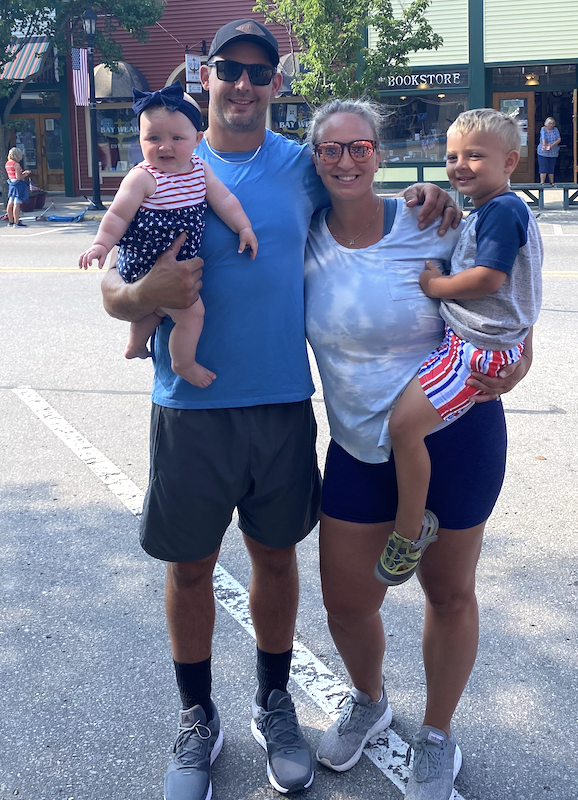
CPR Training, CAP Add to Preparedness
By
Geoff Kimmerly
MHSAA.com senior editor
October 12, 2015
A recent graduate from Ovid-Elsie High School named Chris Fowler started classes this fall at Michigan State University, his days representing the Marauders on the basketball court, football field and golf course now memories as he starts the next chapter of his young adult life.
But his story also will remain a reminder as his high school’s athletic department prepares each year to keep its athletes as safe as possible.
Three years ago next month, Fowler collapsed on the football practice field in cardiac arrest. The then-sophomore was brought back to life by two of his coaches, who revived him with CPR and an AED machine.
There’s no need for athletic director Soni Latz to recount the events of that day when explaining the importance of being ready to respond to a medical crisis – her coaches are well aware of why Fowler survived and understand completely why they too must be prepared.
“Everyone is very aware of what happened and the importance of being trained and knowing what to do, and actually feeling comfortable to step in and administer CPR when needed,” Latz said. “You can feel it’s never going to happen to you, but once it has, it makes you more aware and conscientious to be prepared.”
But Fowler’s story is worth noting on a larger level as varsity coaches at all MHSAA member schools are required this year for the first time to become certified in CPR, and as the largest classes in Coaches Advancement Program history begin course work that includes up to four modules designed to make them aware of health and safety situations that may arise at their schools as well.
The CPR requirement is the most recent addition to an MHSAA thrust toward raising expectations for coaches’ preparedness. The first action of this effort required all assistant and subvarsity coaches at the high school level to complete the same rules and risk minimization meeting requirement as high school varsity head coaches beginning with the 2014-15 school year.
The next action, following the CPR mandate, will require all persons hired as a high school varsity head coach for the first time at an MHSAA member school after July 31, 2016, to have completed the MHSAA’s Coaches Advancement Program Level 1 or Level 2.
In addition, MHSAA member schools this summer received the “Anyone can Save a Life” program, an emergency action plan curriculum designed by the Minnesota State High School League to help teams – guided by their coaches – create procedures for working together during medical emergencies.
“Coaches get asked to do a lot, and even if a school has an athletic trainer or some other health care professional, that person can’t be everywhere all the time. Coaches often are called upon to be prepared for (medical) situations,” said Gayle Thompson, an adjunct assistant professor at Albion College who formerly directed the athletic training program at Western Michigan University and continues to teach CAP sports medicine modules.
“The more (coaches) can learn to handle the situations that can inevitably arise, the better off they’re going to feel in those situations and the better care they’ll be able to offer their athletes. It’s proven that the faster athletes are able to get care, the quicker they’re able to come back to play.”
 Pontiac Notre Dame Prep – which has sent a number of coaches through the CAP program – began a focus on heart safety about five years ago after a student-athlete was diagnosed with a heart issue that allowed her to continue to play volleyball and softball, but not basketball. Athletic director Betty Wroubel said that prior to the student’s diagnosis, the school did provide training in CPR, AED use and artificial respiration; however, that situation put coaches and administrators further on the alert.
Pontiac Notre Dame Prep – which has sent a number of coaches through the CAP program – began a focus on heart safety about five years ago after a student-athlete was diagnosed with a heart issue that allowed her to continue to play volleyball and softball, but not basketball. Athletic director Betty Wroubel said that prior to the student’s diagnosis, the school did provide training in CPR, AED use and artificial respiration; however, that situation put coaches and administrators further on the alert.
Her school offers CPR training also to subvarsity and middle school coaches, using a combination of video instruction from the American Red Cross and in-person guidance by members of the school community who are certified to teach those skills. Students at the school also have received training – and it paid off a few years ago when one of them gave CPR to a baby who had stopped breathing at a local shopping mall.
Portage Central scheduled two sessions this fall for its coaches to receive not only CPR certification, but AED training as well. Central was fortunate to have an American Red Cross first-aid trainer in house, teacher Rachel Flachs, who also is close to the athletic side as the girls swimming and diving coach at Mattawan High School.
Central athletic director Joe Wallace said the training was offered not just to varsity head coaches, but every head coach on every level of the program so that “at least we know that at every given practice, every game, we’d have someone recently trained,” he said.
And he was proud of how his coaches immersed themselves in the subject matter.
“They were putting themselves in scenarios to see how it related to their own sports and asking really great questions,” Wallace said. “It was thought provoking.”
The CAP sports medicine modules are designed to do the same as coaches consider the medical situations they could face. They aren’t designed as “medical training,” said Tony Moreno, a professor of kinesiology at Eastern Michigan University and teacher of all four CAP sports medicine modules. Rather, attendees receive an awareness and basic education on common injuries, injury mechanisms and prevention, and how to create an action plan in the event of an injury incident.
The CAP program touches on a variety of safety topics in several of the available seven levels of coach education.
CAP 1 – which is part of the mandate for new coaches beginning next school year – includes “Sports Medicine and First Aid.” Cap 4 has modules titled “Understanding Athlete Development” and “Strength and Conditioning: Designing Your Program.” CAP 5 includes the session, “Peak Health and Performance.” Attendees also have the option of receiving CPR and AED training as an addition to some courses.
With a quick Internet search, coaches have no trouble finding a variety of resources on sports medicine, performance enhancement, nutrition and healthy living regarding young athletes. “However, some of these sources are more credible and scientifically-based in comparison to others,” Moreno said. “CAP strives on an annual basis to continue to update and improve the quality and credibility of this information and in a face-to-face manner where coaches have the opportunity to ask questions about their experiences and specific programs.”
“Having the CAP requirement will only make them better informed. Many have had this kind of information before, but there’s always something new coming,” Thompson added. “I think we do a good job, not of trying to tell them they were wrong, but maybe taking what they’ve known a step further and making them better prepared – empowering them to do their best.”
Wroubel may understand more than most athletic directors the growing list of tasks coaches are asked to accomplish; she’s also one of the winningest volleyball and softball coaches in MHSAA history and continues to guide both Fighting Irish programs.
But she and Wallace both said the CPR mandate isn’t considered another box to check on a to-do list; there’s enthusiasm because of its importance and the opportunity to carry those skills into other areas of community life as well.
Wroubel has served as a coach since 1975 and said this renewed emphasis on coaches having knowledge of sports medicine actually is a return to how things were when she started. Back then, coaches were responsible for being that first line of medical know-how, from taping ankles to providing ice and evaluating when their athletes should make a trip to the doctor’s office.
“When I first started coaching, we didn’t have sports medicine people, trainers, or team doctors other than for football. You did everything yourself,” Wroubel said. “I think everybody got away from that, but I think it’s coming back because a trainer can’t be everywhere.
“It’s healthy and it’s good for kids. … The more of us with emergency skills, the better we’re able to serve our community.”
PHOTOS: (Top) Portage Central coaches receive CPR training earlier this fall. (Middle) Pontiac Notre Dame Prep coaches practice during AED training. (Photos courtesy of school athletic departments.)

Frankfort Hoops Staff Bolstered by Past Stars Giving Back in Banktson, Kreski
By
Tom Spencer
Special for MHSAA.com
July 18, 2023
Veteran Frankfort girls basketball coach Tim Reznich will have a couple of true superstars on his bench this winter.
 They don’t have MHSAA eligibility remaining, but they should really help the Panthers. They’ve used up their college eligibility as well.
They don’t have MHSAA eligibility remaining, but they should really help the Panthers. They’ve used up their college eligibility as well.
They are Lindsey (Pettit) Banktson, a 2008 graduate of Portland High School and all-state forward, and Presley (Hudson) Kreski, a 2014 product of Wayland High School and all-state guard. And, they are now serving as assistant coaches for Frankfort.
Banktson has been on Reznich’s bench 10 years, and Kreski is headed for her first at Frankfort. Kreski has been on women’s basketball coaching staffs at Western Michigan University and Central Michigan University since her playing days.
“I have always felt very fortunate in my situation at Frankfort,” Reznich said. “I have felt like we have always been able to provide our players with the resources and opportunities to excel at basketball, if that is what they wanted to do.
“When Lindsey came those resources increased, and now adding Presley to the mix just brings everything over the top,” he continued. “Our players are already starting to realize it.”
Kreski, who will be teaching health and physical education at Frankfort, and Banktson, now a physician assistant with Crystal Lake Clinic, are excited to work together and with Reznich this winter as he begins his 22nd season at the helm of the Panthers.
“I’ve loved coaching with Rez the past 10 seasons and am just as excited for season number 11,” said Banktson, who went on to play basketball and softball at Ferris State University. “Every year, the night before our first day of practice, is always like Christmas Eve for me.
“I can’t sleep and I can’t wait for my alarm to go off to head to the gym to start our 2-a-days,” she continued. “I am so grateful to coach with Rez and learn from him.”

Kreske too is eager to work with Rez after getting involved with the Panthers in summer ball.
After Wayland, Kreski went on to an illustrious playing career Central Michigan where she won the NCAA 3-point contest in 2019. She also played with the Seattle Storm of the WNBA before playing professionally overseas in Poland.
“I am really excited to be at Frankfort and helping the team out,” Kreski said. “The girls work really hard and want to get better.
“Tim is a great coach, and I am looking forward to working with him and sharing my knowledge of the game as well as learning from him.”
Frankfort is coming off a District championship in 2022 and a District title loss to eventual Division 4 champion Glen Lake in 2023.
Reznich says the Panthers have already noted keys to success just by being around Kreski and Banktson. Reznich, who guided Frankfort to back-to-back Class D championships in 2005 and 2006, admits he may have softened up a bit on his players over the years. Conditioning will be a top priority this year.
“They (Kreski and Banktson) have the first-hand experience of the benefits of pushing yourself hard and not cutting corners,” Reznich said. “Our players will be in the best shape of their lives when those two are finished with them.”
And Banktson is happy to pass on her high school experience to the Panthers. She graduated in 2008 as the Lansing State Journal’s “Female Prep Athlete of the Year” after shining in three sports and leading Portland to the season’s final weekend in two.
“As a player, high school athletics taught me a lot about hard work and dedication,” she said. “High school sports taught me that you have to put in the extra work if you want to be great.
“You have to be in the gym getting extra shots outside of practice, you have to be at the field getting extra reps on the weekends,” she continued. “If you work hard and give everything you’ve got to develop your game, you will be successful.”
Kreski recalls fondly her high school days working hard and having fun with her friends and teammates, along with making deep runs in the tournament.
“High school sports is the truest form of competition,” Kreski said. “It starts with a community who supports everyone from a young age and involves all the friends and family you grew up with.
“High school sports help guide young people into leaders, teaching them how to work hard and be disciplined.”
Kreski led CMU to Sweet 16 her junior year. She is the all-time leading scorer at CMU (2,309) and career assist leader (643). Central won the Mid-American Conference three times during her days with the Chippewas. She married Gage Kreski after that chapter of her career was done.
Banktson met her husband Max Banktson at Ferris State, where he played football. They moved to Frankfort, where Max was born and raised. They have a 3-year-old son named Briggs and a 6-month old daughter named Landyn.
Both Reznich and Banktson express respect and appreciation for their coaching together. They’ve been on the same page with game plans and scouting reports, and they expect it will continued with Kreski aboard.
“Rez and I really work well together,” Banktson said. “He has always respected me as a player and coach and has given me so much autonomy with our teams.
“He is always open to my input when it comes to running certain drills in practice, putting in new offenses, or adding defensive schemes,” she continued. “He trusts me to handle our subbing during games.”
Reznich agrees.
“I have always appreciated Lindsey’s perspective on what the girls are doing on the court,” he said. “It is going to be a lot of fun and exciting to add Presley’s ideas.
“We have always treated the regular season as practice for the tournament, making adjustments and tweaking things,” he continued. “I can’t wait to see the end product this year.”
 Banktson was a three-sport, four-year varsity player at Portland earning a combined 12 varsity letters in basketball, softball and volleyball. She helped the Raiders win league, District and Regional titles. Her teams reached MHSAA Semifinals for softball twice and basketball once.
Banktson was a three-sport, four-year varsity player at Portland earning a combined 12 varsity letters in basketball, softball and volleyball. She helped the Raiders win league, District and Regional titles. Her teams reached MHSAA Semifinals for softball twice and basketball once.
It doesn’t take much to get her back in game mode.
“I can still remember the feeling of adrenaline getting ready in the locker room with my teammates, running out to our warm up music, and battling on the court each game,” she said. “I am thankful for my teammates who, when on the court, were so unselfish. We just wanted to win.”
She hopes to continue to instill greatness in the Panthers.
“I always tell the girls, ‘We were tough’ — not just physically but mentally,” she said. “We had a type of swagger – we played like we knew the bullseyes were on our back, and every game we had to fight to stay at the top.
“We took pride in wearing that Portland Raider jersey,” she continued. “I just want to instill that same mental toughness and swagger into my girls here at Frankfort.”
Having a pair of women who played now coaching and serving as mentors is beneficial on a personal level as well.
“I feel like I can relate to players on a personal level,” Banktson said. “I always try to be a good role model for them and someone they can come to with anything.
“I’m their biggest cheerleader but also not afraid to hold them accountable and help steer them down the right paths of life.”
And Banktson has learned how she might have coached herself.
“I would push myself to continue to work on my right hand, because everyone in the gym knows I’m a lefty,” she said with a smile.
2023 Made In Michigan
July 12: Championship Memories, High School Tennis' Impact Stick with Hackett Pair - Read
July 6: Brother Rice Finals Hero Aiming to Ace Family Life, Financial World - Read
July 5: Lapeer West 4-Time Finals Winner Set to Build Champions at Oklahoma - Read
PHOTOS (Top) Lindsey Banktson plays at Portland in 2008 and stands for a celebratory photo with Frankfort’s District champion last season. Presley Kreski plays for Wayland in 2014 and more recently served on Central Michigan's coaching staff. (Middle) Kreski directs the offense during her time at CMU. (Below) The Banktson family: From left, Landyn, Max, Lindsey and Briggs. (Photos of Banktson courtesy of Lindsey Banktson. CMU photo courtesy of CMU sports information. Wayland photo courtesy of Joel Bissell, MLive.com)

